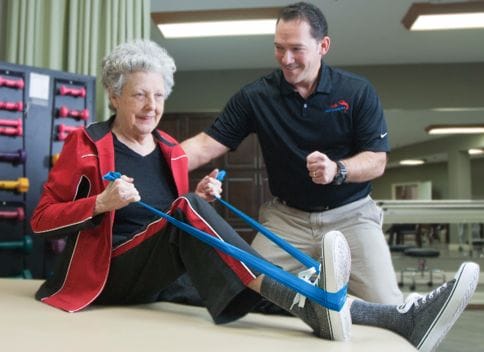You’ve had it! You have lived with your knee pain for years, but you realize your quality of life is suffering. It has become too hard to take the stairs and you’re getting tired of walking like an “old person.” But you are still anxious because there’s much to consider like who is the right surgeon and what is the best procedure for your situation.
As you do your personal research, consult with your physician and talk with others who have had joint replacement surgery. In doing so, you will begin to realize that though there will be some pain, surgical advances over the years make the process quicker and the benefits significant.
You may also have discovered that those with the best results after surgery took advantage of post-surgical rehabilitation. This ensures that when you begin moving, you do so to protect your new joint while strengthening the muscles that help you move. You have medical guidance on when and how much pain medication to take, when to rest and when to push yourself a little more. Most people recover in four to six weeks. Of course, the more intensive the rehabilitation, the quicker the recovery. You may still be a bit sore, but you will be moving around safely! Recovering in a “supervised” environment means that you will be away from home a little longer- but you will be increasing your odds for a very successful recovery!
How much pain should I expect?
Pain management has evolved and improved dramatically over the last several decades. Multimodal pain management, that is, using several different types of pain meds, is highly favored by many physicians and therapists. This approach tries to limit narcotics (such as codeine and Vicodin) due to their side effects and risk of addiction. Multimodal management works best in a supervised environment.
What are my rehabilitation options after knee replacement surgery?
You may receive therapy at home, at an out-patient clinic or an in-patient rehabilitation unit. While it may be tempting to get home as soon as possible, there are some pitfalls. If you live alone or don’t have someone to care for you, you will need assistance initially. You will need equipment to assist you getting around, and there is a risk that you might re-injure yourself should you move incorrectly or fall. Home therapy is limited as there is no equipment for the therapist to use and rarely are they able schedule daily sessions. There is no one to check on your bandages or help with pain management. Without patient services, you will need transportation as you won’t be driving for several weeks.
What are the benefits of in-patient rehabilitation?
You can relax. Doctors and nurses will check your incision and bandages, monitor your pain and ensure you get your meds correctly and on time. Your family members can dote on you- bring you your favorite foods, books, lattes- and not worry that they will let you fall while helping you in the bathroom.
Your therapy will be five or six days a week- focusing on how you move, how you heal and how much strength you regain. They have specialized machines to help maximize your exercises. They will work with you so you walk safely and have confidence, so you regain your swagger!
Here are some others to consider:
- Gain strength and range of motion
- Learn about pain management strategies
- Learn about safety precautions (Dos and Don’ts)
- Learn techniques to minimize pain and conserve energy while using a cane or walker, getting in and out of bed, etc.
- Get training for you and your family so that you may resume your normal home life and leisure activities.
American Senior Communities offers a variety of in-patient and outpatient rehabilitation services with its Moving Forward Rehabilitation program. Contact us today to learn the best options for you and your family’s needs. You can even tour several of our centers nearest your home and meet your future caregivers!



